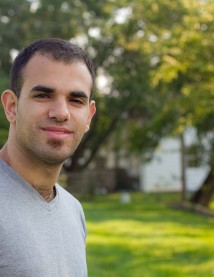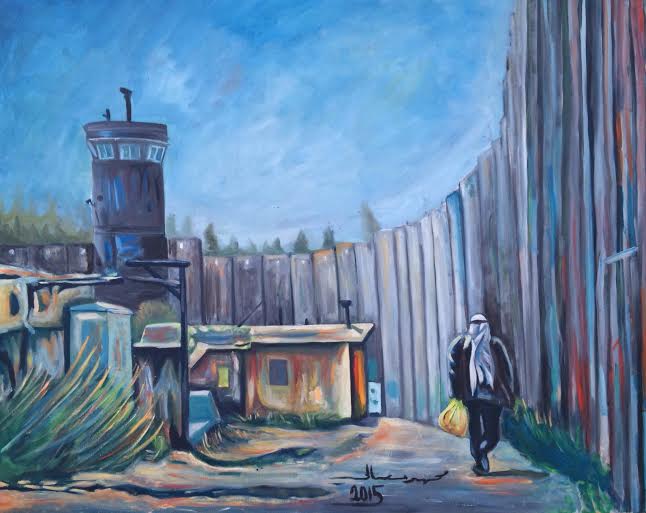After first visiting Washington D.C. in 2011, Bshara Nassar was struck by the fact that among the city’s dozens of museums, there was “no place for the Palestinian story to be told.”

Over the next several years, as he worked on a master’s degree in conflict transformation from Eastern Mennonite University’s Center for Justice and Peacebuilding (CJP), the thought continued to turn in Nassar’s mind. He was particularly interested in telling the little-known story of the “Nakba,” which means “catastrophe” in Arabic. The term is used to refer to the displacement of more than 700,000 Palestinians from their homes in 1948 when the State of Israel was created. Today, nearly 5 million people, nearly all of them descendants of the original group, are registered as Palestinian refugees with the United Nations. (Nassar’s grandmother is one, though he is not.)
Following his graduation from CJP in 2014, Nassar moved to Washington D.C. and dedicated himself to founding what he’s calling the Nakba Museum Project of Memory and Hope. After a successful fundraising campaign earlier this year, that project will formally launch on June 13, 2015, with the opening of a two-week art exhibit at the Festival Center in Washington D.C.
The exhibit will feature the work of six Palestinian refugee artists. Nassar chose to use their painting and photography as the primary method of telling the refugees’ story because art “is a language that everyone can understand.”
“This is not about victimhood, politics or religion,” said Nassar, acknowledging the controversy and divisive rhetoric that often surrounds the issue of Palestinian refugees. “We want deep conversations that can lead to equality and justice in Israel and Palestine…. I’m trying to tell stories that people haven’t heard.”
Art is a common language
To do that, he’s recruited a team that’s helped with various aspects of the project. One of the artists whose work will be featured in the upcoming exhibit, painter Ahmed Hmedat, curated the show by recruiting other Palestinian artists and helping assemble their work for display. Hmedat will speak on the opening night and remain in Washington as an artist-in-residence throughout the two-week run.
Another collaborator of Nassar’s was an American Jewish friend named Sam Feigenbaum, who did the exhibit’s website and graphic design.
“I just wanted to prove that somewhere in the world that a Jew and a Palestinian could get along,” said Feigenbaum, who had first met Nassar several years earlier and got back in touch with him after the outbreak of a war in Gaza last fall.

“What’s nice about this exhibit is that it uses a means of communication that is not necessarily dependent on language or education. You don’t need to know about the Nakba in order to experience it through the art. My hope is that people will see something that hits them on an emotional level, and then start asking questions,” he said.
According to CJP Executive Director J. Daryl Byler, better understandings of the historical bases for conflicts, such as the Nakba, “helps us to imagine what issues will need to be addressed in order to transform a destructive conflict into a sustainable future for the parties to the conflict.”
“This project includes the tagline, ‘Memory and Hope,’ which helps cast a positive vision for a future of Israelis and Palestinians living side-by-side as neighbors,” continued Byler, who along with his wife, Cynthia, is a sponsor of the upcoming exhibit. “[Nassar’s] theory of change seems to be that hope for a future together is rooted in remembering the past when Jews and Arabs shared the land, largely in peace.”
‘We refuse to be enemies’
Nassar emphasizes that the museum is as much focused on the present as the past, and describes the Nakba as an ongoing event for Palestinian refugees who still live in camps and for all Palestinian people who live under occupation. To address that reality in their own lives, Nassar’s family founded an organization called Tent of Nations. Based at their 100-acre farm in the West Bank, near Bethlehem, it is dedicated to building respect and understanding between different people and cultures.
That hasn’t prevented them from living under constant fear of displacement, however. For years, the family has fought a legal battle in Israeli courts to block plans to seize parts of their land for development, and in 2014, military bulldozers uprooted 1,500 fruit trees and grape vines on their farm.
In life generally, and in his efforts to found a museum to tell the Palestinian story, Nassar continues to draw inspiration from a stone at the entrance to the family farm, inscribed with the words, “We refuse to be enemies” in three languages.
“I’m also inspired by CJP and the EMU environment that supports and empowers peacebuilders locally and around the world. I’m deeply appreciative,” said Nassar.
Although no future exhibitions have been planned beyond June, the Nakba Museum Project of Memory and Hope will be an ongoing one. One of Nassar’s biggest goals is to eventually find a permanent space to tell the refugees’ stories, in the service of memory and hope.
